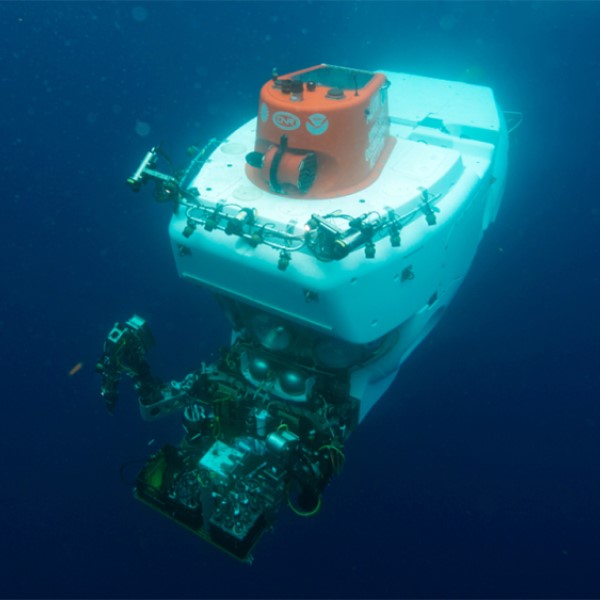Texas A&M Oceanographers On 30-Day Pacific Expedition Will Be Featured On BBC Blue Planet Live March 27-28
Dr. Jason B. Sylvan is serving as chief scientist for the NSF-funded research cruise studying East Pacific Rise hydrothermal vent ecosystems, with three Texas A&M Aggies also aboard.
Mar 28, 2019


Visually magnificent and biologically significant, ocean-floor hydrothermal vents were completely unknown to scientists until 1977. Today oceanographers are still working to understand the ecosystems around live and inactive vents, and the implications for deep-ocean science and ocean exploration policy.
To get those answers, an expedition funded by the National Science Foundation (NSF) is sailing next week, led by cruise Chief Scientist Dr. Jason B. Sylvan, assistant professor in the Department of Oceanography in the College of Geosciences at Texas A&M University. The expedition aboard the R/V Atlantis leaves San Francisco March 25 with a group of 16 scientists, and returns to San Diego April 24. The science team will study vents on the East Pacific Rise using Alvin, a three-person human occupied vehicle (HOV) submarine.
BBC-One will also be on board and broadcasting live from the first leg of the expedition. BBC-One’s Blue Planet Live program will air footage from the R/V Atlantis on March 27 and March 28, and that footage will be available online.
“We call this research project Hot2Cold Vents, and it is an interdisciplinary effort to understand the microbial communities that make up hydrothermal vent ecosystems, with a focus on what happens after active vents cease venting,” Sylvan said. “There’s so much we still don’t know about hydrothermal vents, which have only been studied for about 40 years.”
Dr. Margaret K. Tivey, vice president for academic programs and dean of administration at Woods Hole Oceanographic Institution (WHOI), and Dr. Brandy Toner, associate professor in the Department of Soil, Water, and Climate at the University of Minnesota, are co-leaders of the expedition.
In recent years, scientists have been studying hydrothermal vents that become inactive after venting ceases. These vents are potentially important ecosystems in the deep sea because although hydrothermal fluids no longer flow out of such vents, “they can last for tens of thousands of years, and therefore may contribute to deep-sea chemistry and biology,” he said.
“In addition, these inactive vents are potential targets for deep-sea mining for precious metals,” Sylvan said. “Therefore, it is important to gain a deep understanding of their ecology, so that informed decisions can be made if seafloor mining does become a reality.”
Aggies Getting Research Experience In The Pacific
Three Texas A&M Aggies will also be on board the ship as part of the science team. Oceanography postdoctoral research associate Amanda Achberger will be conducting radiotracer assays, or radioactive bioassays, on the expedition to determine microbial rates of primary production and heterotrophic production.
“That data tells us how much carbon is made and how much is eaten up in an environment,” Sylvan said.
Oceanography graduate student Charles Holmes II will be conducting sulfide microbiology research and processing rock samples for later analysis at Texas A&M. And, sophomore environmental geosciences major Mia Self will be responsible for analyzing microbial exoenzymes.
Scientists have found that the microbes living on inactive vents are very different from microbes dwelling near active vents, but they don’t yet know if that transition occurs quickly or over many years, Sylvan said. This research project will examine how microbial communities and geological conditions change when a vent changes from active to inactive. Understanding these processes will add to scientists’ knowledge of hydrothermal vents and the biology and chemistry of the deep ocean.
HOV Alvin is brought back aboard the RV Atlantis following a dive. (Video courtesy of Woods Hole Oceanographic Institution.)
Getting Face-To-Face With Hydrothermal Vents
Sylvan will be in Alvin for some of the 16 dives that the submersible will make during the 30-day expedition. The HOV’s amazing mobility and capabilities allow scientists to see the deep ocean up-close and personal, Sylvan said.
“It’s amazing what you can miss when you’re looking at the ocean floor remotely from a camera, but in the Alvin we get almost an 180-degree view, and we can see sites we might otherwise miss,” he said.
Alvin is owned by the US Navy and maintained by WHOI, and it enables in-situ data collection and observation by two scientists to depths reaching 4,500 meters, during dives lasting up to ten hours, according to WHOI. Alvin’s equipment can also collect samples of rocks, sediment, fluids, and sea life.
This research cruise is the first expedition of the project, and the second expedition will sail in the spring of 2020, returning to the same locations to study the same vents, again using Alvin or potentially a remotely operated vehicle, Sylvan said.
Learn more about this research at Dive into our research at bit.ly/hot2coldvents. To follow the expedition on social media, follow #Hot2ColdVents and @tamugeosciences.
By Leslie Le ‘09

